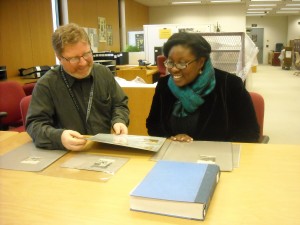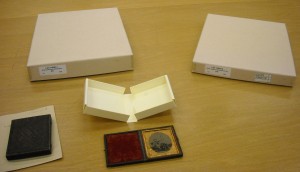Our online collections support many a research project, but contact with physical photographs and graphic items can be eye-opening and reveal new avenues for investigation.
Kya Mangrum, a doctoral candidate in English Language and Literature at University of Michigan, Ann Arbor, recently spent several days in the Prints and Photographs Reading Room exploring images of former slaves in our Civil War collections. On her last day here, she graciously agreed to chat with Reference Specialist, Jeff Bridgers, about her experience while they looked at some of the collection materials she had requested.
Jeff: You’ve been here several days: why the Library of Congress?
Kya: I’m writing a dissertation chapter about visual and narrative representations of contraband, or former/fugitive slaves. For my subject, I found that the Library of Congress had the most comprehensive collection of photographs about the U.S. Civil War, and several photographs of contraband. I deduced that from my pre-doctoral research, looking at books, and seeing how the images were credited.
Jeff: Any surprises while you were here—”aha” moments?
Kya: I’d say that the biggest "aha" moment was when I discovered the relationship between the different photographers, and realized how enormous the archive was for photographs taken during that era. I really didn’t realize how many photographs there were—more than I ever thought were taken of African Americans—both free and “contraband.” The Beaufort, South Carolina photographs were the ones I was most familiar with. Finding so many new images in the Gladstone Collection was really exciting. I got to see the daguerreotype of Mary Bryce, an image that was also new to me. It wasn’t digitized, so I got to view the original. I wouldn’t have had that experience if I hadn’t come here.
Jeff: Any other thoughts about your experience here?
Kya: The staff here is really great.
What really impressed me was how kind and helpful everyone has been. I wasn’t expecting everyone to be so generous with their time. There were several moments when a casual conversation led me to a really productive path in my research.
Although I had looked at the collections online, I really didn’t understand how much was here until I got to LOC and people showed me how to do different types of searches. I also learned about materials in associated collections—at the National Portrait Gallery and in the Library’s Manuscript Division—by talking to LOC staff.
In addition to viewing a daguerreotype we have not yet digitized and many photographic prints and reference books, Kya was here at just the right time to take advantage of our newly available “History of photography study samples” group (LOT 14020), which enabled her to see up close the variety of photographic formats in play during the Civil War, including tintypes, ambrotypes, daguerreotypes, and stereograph cards.
We are grateful to Kya for sharing her thoughts with us, and glad that funding from her university, through a Rackham Research Grant, enabled her to make the trip.
If you are planning a research visit, please get in touch with us in advance, as Kya did, so that we can help you make the best use of your time here. We offer several means of contacting us on our Ask a Librarian page.
Learn more:
- View our “Top Tips for Successful Research in the Prints and Photographs Division” and the associated “Information for Researchers” page.
- View our Researcher’s Toolbox—resources for exploring and understanding images.
- View a list of dissertations and theses that have tapped P&P collections.


